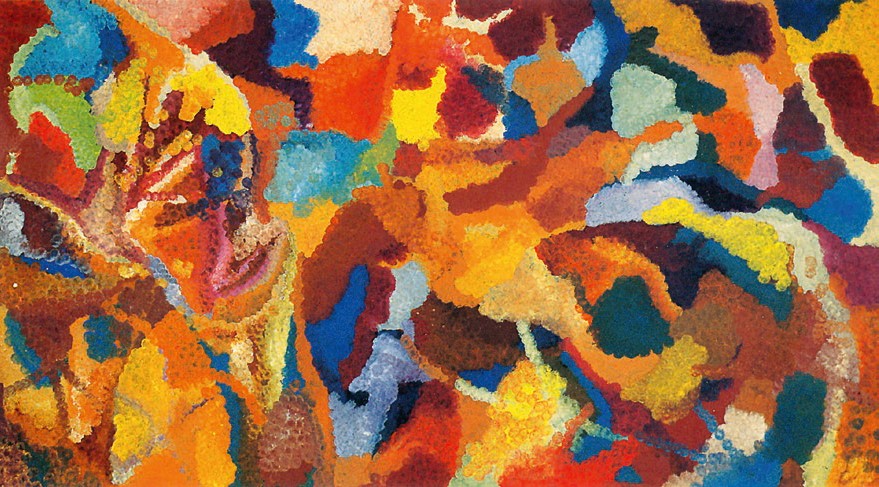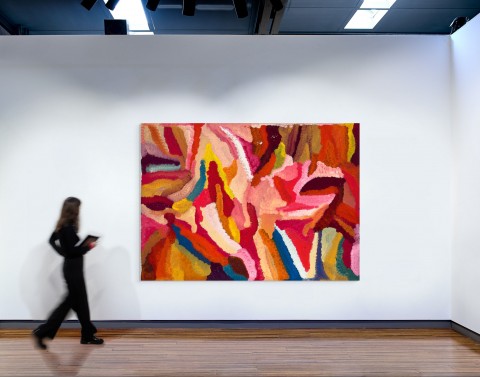UNTITLED (AWELYE), 1992
EMILY KAM KNGWARREYE
synthetic polymer paint on canvas
164.0 x 228.0 cm
bears inscription verso: artist's name, 'Rodney Gooch' and Mulga Bore Artists cat. 4.892
Mulga Bore Artists, Alice Springs, Northern Territory
Hugh Jamieson Collection, Sydney
Private collection, New South Wales
Deutscher and Hackett, Melbourne, 18 May 2011, lot 12 (as ‘Untitled’)
Private collection, Perth
Deutscher and Hackett, Melbourne, 27 November 2013, lot 139 (as ‘Untitled’)
Private collection, Brisbane
Emily Kame Kngwarreye: Alhalkere, Paintings from Utopia, Queensland Art Gallery, Brisbane, 20 February – 13 April 1998, then touring to: Art Gallery of New South Wales, Sydney, 15 May – 19 July 1998; and National Gallery of Victoria, Melbourne, 8 September – 22 November 1998 (label attached verso, as ‘Untitled’)
Utopia: The Genius of Emily Kame Kngwarreye, National Museum of Art, Osaka, Japan, 26 February – 13 April 2008; National Art Centre, Tokyo, Japan, 28 May – 28 July 2008; National Museum of Australia, Canberra, 22 August – 12 October 2008, cat. C-10 (as ‘Untitled’)
Sharjah Biennial 15: Thinking Historically in the Present, (curated by Hoor Al Qasimi), Sharjah Art Foundation, emirate of Sharjah, United Arab Emirates, 7 February – 11 June 2023 (as ‘Untitled’)
Neale, M., Emily Kame Kngwarreye: Alhalkere, Paintings from Utopia, Macmillan Publishers, Melbourne, 1998, cat. 54, pl. 67, pp. 43 (illus., detail), 60, 106 – 107 (illus.)
Neale, M. (ed.), Utopia: The Genius of Emily Kame Kngwarreye, National Museum of Australia and the National Museum of Art, Osaka, Japan, 2008, cat. C-10, pp. 149 (illus.), 162 (illus.), 237
This work is accompanied by a copy of the certificate of authenticity from Mulga Bore Artists.
Emily Holmes a court.jpg

Deeply rooted in the Anmatyerr land of her ancestors to whom she paid respect through a lifetime of devotion to women’s ceremony in song, dance and the ceremonial painting of bodies, the art of Emily Kam Kngwarreye reveals a deep affinity to the country and the ever-changing desert landscape in her father and grandfather’s Country of Alhalker. The youngest of three children, Kngwarreye chronicled on canvas this triangular-shaped country – the place she was born, and where she lived in the ways of the eastern Anmatyerr. In the 1930s, the traditional life of the Anmatyerr and Alyawarr people was forever disrupted when the borders of the Utopia pastoral lease were drawn across their lands. Over time, many local people, including Kngwarreye, found periodic work on the emergent pastoral stations. Sixty years later, in 1977, Kngwarreye was introduced to batik as part of adult education classes held on Utopia Station hosted by Jenny Green and Julia Murray, and a decade on, in 1988 – 89, Emily painted her first work on canvas, sparking a meteoric rise to fame.
Kngwarreye’s brush strokes reveal a strength and sureness of hand that delivers an exuberance of gesture. Her paintings are constructed of various elements that over time were added to, or eliminated from, the surface of the canvas. Underlying grids structure the compositions, sequences of dots aligned between or over lines, dashes and linear marks, meandering lines, and areas of dots applied on dots that allow a build-up of layers of colour. These elements constitute the artist’s lexicon and are used separately or in varying combinations, thus allowing her work to evolve and be constantly fresh.
150626.jpg

This vibrant painting belongs to a group of works produced between the beginning of 1992 and the end of 1993 that have been described as her ‘high-colourist period.’1 This phase of production was characterised by a succession of intensely bright paintings executed in a multi-coloured palette where vibrant hues are sandwiched into squares and oblongs which lead the eye up, down and across the surface in a staccato movement.2 In this work, painted for Rodney Gooch’s Mulga Bore artists in early 1992, irregular shapes pulsate with intuitive combinations of hot pinks, citric oranges, deep blues and maroons colliding together yet contained by the rectangular shape of the canvas. These blocks of colour are formed by building-up layers of dots resulting in solid forms – a deviation from her earlier more pointillist application of dots where each defined layer of dots was expressed in the canvas.
Significantly, Untitled (Awelye), 1992 was created at a time when Kngwarreye’s painting was itself undergoing a process of transformation, with the artist abandoning the background tracery of the underlying yam roots (a consistent compositional device in her earlier paintings) and transitioning instead into fields of pure dots. Her mark-making also became looser and more expressive. Kngwarreye’s expression in paint was less inhibited; lines and dots were blurred into expansive gestures with blocks of colour replacing dots and sinuous lines. This was also a time when Kngwarreye experimented with colour and broadened her palette beyond traditional earthy hues and their derivatives, to incorporate vivid oranges, blues, greens, maroons, and pinks, as featured here. Kngwarreye suggests not only a sense of delight in the colours of the landscape; rather, now colour itself becomes both the impetus for – and subject of – such paintings.
Untitled (Awelye), 1992 belongs among a sequence of major works on a similar scale in which Kngwarreye celebrates the natural bounty of the desert in favourable seasons. Related works in this series include Alhalkere (I) painted in the winter of 1992 and held in the Janet Holmes à Court collection, Perth;3 Alhalkere (V), 1992 (private collection);4 and the Alhalkere Suite, painted in October of the following year, now in the collection of the National Gallery of Australia.5
1. Neale, M. (ed.), Utopia: The Genius of Emily Kame Kngwarreye, National Museum of Australia and the National Museum of Art, Osaka, p. 149
2. ibid.
3. See ibid, plate C-2, pp. 150 – 151 (illus.)
4. See ibid, plate C-4, p. 155 (illus.)
5. See ibid, plate C-7, pp. 156 – 157 (illus.)
CRISPIN GUTTERIDGE

